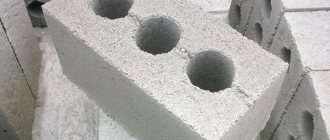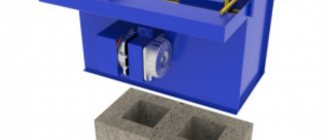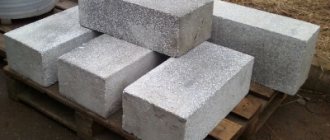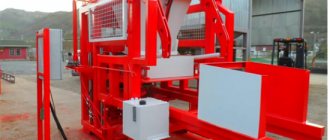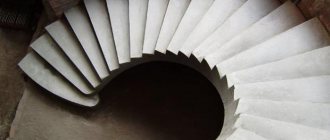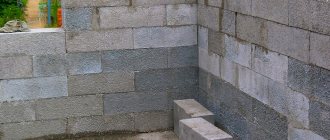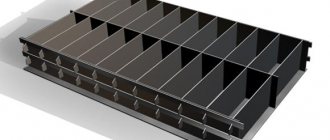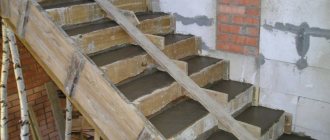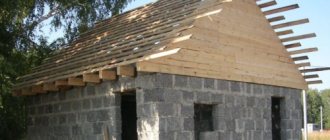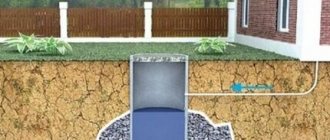Beton-House.com
Website about concrete: construction, characteristics, design. We combine the experience of professionals and private craftsmen in one place
Metal mold for making foam concrete blocks
Formwork in the production of cellular concrete is one of the most important things, so you need to treat its choice no less carefully than the main equipment. Factory-made or home-made foam concrete molds are a dilemma that sooner or later faces any owner or workshop foreman. What is more profitable, and in what case exactly, we will analyze in more detail.
Features of the material
Cinder block is a building material that has proven itself to be one of the most durable and unpretentious.
It has considerable dimensions, especially if you place an ordinary brick next to it. You can make slag blocks not only in a factory setting. Some craftsmen undertake this work at home. If you strictly adhere to the technology, you get high-quality and strong blocks from which you can build a house or any outbuilding. If a decision has been made to independently produce such products, then a number of its features should be taken into account.
- Cinder block is a fireproof material. It does not ignite itself, and does not intensify an existing flame.
- Really good quality blocks make long-lasting and sustainable homes/outbuildings. Such buildings will not be harmed by harsh climatic conditions, hurricanes, or constant gusty winds.
- Repairing cinder block buildings does not require extra effort and free time - all work can be completed in a short time.
- Cinder blocks are also distinguished by their large sizes, thanks to which buildings made from them can be erected very quickly, which pleases many builders.
- This material is durable. Buildings built from it can stand for more than 100 years without losing their previous characteristics.
- Another feature of cinder block is its soundproofing component. Thus, in dwellings made from this material there are no annoying street noises.
- The production of cinder blocks is carried out using various raw materials, so it is possible to select the optimal products for any conditions.
- What distinguishes cinder block is that it is not subject to attacks by various kinds of parasites or rodents. In addition, it does not rot, so it does not have to be coated with antiseptic solutions and other similar compounds designed to protect the base.
- Despite their decent dimensions, such blocks are light in weight. This feature is noted by many masters. Due to their lightness, these materials can be easily moved from one place to another without calling a crane. However, it must be taken into account that some types of such products are still quite heavy.
- Cinder block is not afraid of low temperatures.
- These blocks are distinguished by their high heat capacity, thanks to which they make cozy and warm homes.
- Temperature fluctuations do not harm the cinder block.
Cinder block buildings are usually decorated with decorative materials to give a more aesthetic appearance.
However, it is very important to remember that the cinder block cannot be covered with ordinary plaster (any “wet” work with this material should not be carried out). You can also use a special decorative block, which is often used instead of expensive cladding. When working with cinder block, it is important to take into account one important feature - this material is characterized by high water absorption, so it must be protected from contact with moisture and dampness. Otherwise, the blocks may collapse over time. Unfortunately, the geometry of the slag blocks leaves much to be desired
That is why, when laying floors from such material, you will have to constantly adjust individual elements - trim them and saw them. Cinder blocks have a relatively low cost.
Otherwise, the blocks may collapse over time. Unfortunately, the geometry of the slag blocks leaves much to be desired. That is why, when laying floors from such material, you will have to constantly adjust individual elements - trim them and saw them. Cinder blocks have a relatively low cost.
Forms for foam concrete blocks
After manufacturing, foam concrete is in a liquid consistency and spreads over the surface of the equipment, taking into account its viscosity. Not only their size, but also the quality of the finished product depends on the form for the production of foam blocks.
The material and type from which the technological equipment is made primarily depend on the turnover requirements and the scale of production. Turnover depends on the time that passes from pouring to pre-curing.
According to the design features of the form, there are two types - one-piece and detachable. In addition, they may differ in the number of blocks that can be poured at the same time, i.e. single and multi-seat.
Various types of technological equipment make it possible to obtain both finished piece blocks and a solid mass, which, after being removed from the equipment, is cut. Of course, molds for foam blocks are made by hand of the first type, since they allow you to obtain a finished product.
The disadvantage of equipment for the production of piece blocks is that they allow the production of products of a fixed size. Most often, blocks are produced with dimensions of 200*300*600 mm.
The most common materials for making molds are: moisture-resistant plywood, plastic and metal. Not only the technological and operational properties of the equipment, but also its price depend on the type of material.
Plywood forms
Block forms
Plywood forms
As a rule, such forms are made with a metal frame. Metal structures are necessary in order to give the plywood the necessary rigidity and also prevent its deformation. As a result, this has a positive effect on the quality of products.
The main advantage of plywood equipment is its low cost and ease of manufacture. Operation also does not require large expenses. Molds can withstand at least 40-50 pouring cycles. If you properly maintain and care for plywood equipment, it can last even longer.
A do-it-yourself mold for foam blocks is a knocked-down plywood box with cells. Each cell corresponds to the size of the future product.
Plastic mold
Plastic molds
Plastic molds for foam blocks are the cheapest. They are easy to use and do not require lubrication before filling. The disadvantage of such forms is their fragility. This is due to their short service life.
Recently, metal frames have begun to be produced into which plastic equipment is installed. They allow you to increase the durability of the forms.
Metal molds
Metal forms
The most durable are metal molds for foam blocks, but they are also the most expensive. However, if we take into account the length of their service life, the cost of the molds is an insignificant part of the cost of finished products.
Making metal equipment is much more difficult. If you do not have this opportunity, then you can look for used foam block molds, which will cost much less than new ones.
Creating a Form
First of all, you need to decide what kind of machine you need. If you want to build a garage or temporary shed, then a machine with two or even one mold is enough. If you are going to organize a small business, then you will need a more productive machine, at least for 3-4 matrices.
Cinder block dimensions
The most important part of the machine is the shape. The remaining parts and assemblies are additions that allow you to perform various manipulations with this form.
For example - filling, lifting, compacting the solution, moving, etc.
When producing cinder blocks, the plant uses standard iron molds, as well as professional equipment that presses concrete into a mold under a weight of several tons. Do-it-yourself cinder block molds are most often made from wood. There are many types and designs.
In essence, the form is a container into which concrete is poured and where it remains until it hardens completely. It should be noted that the forms must be collapsible so that the finished cinder block can be easily removed. In most cases, they are even made without a bottom, and a plate of material to which concrete does not stick is placed under the bottom.
The easiest way to create voids in a block is to immerse plastic water bottles or glass champagne bottles, which is preferable, into soft concrete at the desired location. But, if you want to set up a small production of cinder blocks with your own hands, then the void formers must be fixed in the mold.
Sketch of a wooden mold
Made of wood
First of all, you will need planed boards, the width of which will correspond to the height of the cinder block. Then it is necessary to make the outer cross members, which will be connected to the longitudinal boards with “sliding grooves”.
Then cuts are made from the inside of the longitudinal boards at a distance equal to the length of the cinder block. The transverse grooves should have a depth of 7 - 8 mm. The width of the cut corresponds to the thickness of the separating plates, which can be made of iron, getinax, textolite.
Sketch of a form filled with solution
The plates can be made from other sheet material, the main thing is that it is smooth. The drawing above shows how to make wooden molds for cinder blocks with your own hands. It is advisable to open the mold details with any oil paint. This will make it easier to remove the cinder blocks from the mold.
Please note that the sketch shows smaller dimensions than a standard cinder block requires. Before creating the mold, you can make your own cinder block drawings
This procedure will not be superfluous and will not require much work.
The above forms are used without a vibrator. The solution in them should be poured into a softer solution with a higher water content. However, with a little effort, you can create a more advanced vibrating machine.
Form-stretcher
The molds for the vibrating table look a little different. Handles must be attached to the sides so that two people can lift them and place them on the vibrating table. There should be two cones at the bottom of each cell.
You should not make a mold with a large number of cells, as such a stretcher will be very difficult to lift. Such forms cannot be disassembled, and the cinder blocks from them are shaken out by tipping them over. The internal surfaces of the mold must be smooth so that the products can be easily removed.
The photo shows a metal form
Made of metal
When creating a machine for making cinder blocks with your own hands, you will need a steel sheet 3-5 mm thick. Shape elements should be cut out of it based on the size of the cinder block. The standard is 190x190x390 mm; in accordance with these dimensions, do-it-yourself cinder block drawings are made. The height of the form should be 5 mm above the block so that you can pour the concrete mixture and press it on top with a plate
Since the cinder block must be hollow, it is important to make the void formers correctly. The easiest way to use pipes for these purposes is
Please note that they need to be given a conical shape. Thanks to this, the product will be easily shaken out
Blanks can be ordered from a turner so that he can remove a few mm from one side of the pipe. Sometimes rectangular void formers are made. Their shape doesn't matter, the main thing is that they are conical. Keep in mind that the cinder block should be no more than 30% hollow.
A wooden or rubber seal should be made at the bottom of the mold along the perimeter to avoid deformation of the edges of the matrix. You can also weld metal plates 20 mm wide along the edges.
Vibrating table of the simplest design
What are blanks?
Since cinder block material varies in size and appearance , there is no single template from which standard products can be produced. Therefore, in the production of slag concrete, special collapsible containers are used, consisting of 4 walls, a bottom (in some types of blanks a bottom is not provided) and matrices (one or several replaceable ones, depending on the size and size).
The number of matrices depends on the volume of products that need to be produced in 1 day. Matrices can be made of wood or metal.
Types of designs
Blanks for the production of cinder blocks are divided according to the material from which they are made and the number of voids in the future product. For the first category, you can write the following. They are:
- Plastic.
- Wooden.
- Metal.
Plastic
Plastic blanks for cinder block products on an industrial scale are not particularly popular. They will not be able to withstand constant pouring over a long period of time . This greatly limits their scope of application. Therefore, only a few manufacturers produce for sale plastic containers for pouring slag concrete.
The plastic structure comes in only one size – 390x190x188 mm.
But the advantage of such structures is that they are light in weight and easy to operate , because the walls of the workpiece do not need to be lubricated each time with used machine oil or a special self-destructive lubricant. In addition, their price is much cheaper than the same products made of metal or wood.
Wooden
Wooden structures are a rectangular box made of laminated plywood. They can be used both in production for the manufacture of large volumes of products, and for home production of cinder blocks.
To give the walls greater rigidity, clamps are used that tighten all 4 walls . And so that the cinder block solution does not destroy the structure from the inside, the bottom and walls are covered with polyethylene.
The advantages of containers made of wood are their average, affordable price (lower than those made of metal), light weight, making the workpieces easy to move around the site and lift, as well as the number of fills - on average 50 times.
But there is also a minus - the material is sensitive to moisture , so pouring the solution into wooden forms should only be done in the fresh air, in dry weather, and the filled forms should be stored in a well-ventilated, not damp area.
Metal
Metal forms come with or without a bottom. And the presence of a bottom divides metal products into solid and collapsible. If there is no bottom in the mold, then the walls of the product do not have sufficient rigidity, so in industrial production they mainly use blanks with a bottom 6 mm thick.
The bottom can be further strengthened with channels, and special metal inserts can also be used, which will allow the production of cinder blocks with a tongue-and-groove system (for partition slabs).
The most popular metal forms are made into 35, 63 or 70 blocks of standard sizes 390x190x188 mm .
What is the best way to fill the forms?
If you are setting up the production of cinder blocks at home, know that there is no universal composition; each master selects his own unique recipe, which is more suitable for a particular bathhouse and which depends on the existing slag. But the standard cinder block recipe is as follows: 7 parts slag, 2 parts sand and 2 parts gravel, 1.5 parts good cement (grade M400) and from one and a half to 3 parts water. The accepted dimensions of a cinder block are 39x19x20 cm, but dimensions of 40x20x20 cm are also used in private construction.
In addition to the slag itself, ash, other coal combustion waste, gravel, processed sawdust, perlite, stone and granite screenings, gypsum, broken bricks and the like are used as fillers for such blocks. For greater plasticity of the blocks, a plasticizer is also added - this is 5 grams per block, during vibration casting. For what? It is this substance that significantly increases the strength of the block, its frost resistance and water resistance, and eliminates cracks.
You need to measure the amount of water especially carefully: the blocks should not spread during removal. You can conduct the following test: if the solution crumbles when it falls to the ground, but comes together in your fist, this is what you need. By the way, concrete for the construction of a small bathhouse can be prepared manually, but for a more serious structure it is better to initially acquire an electric concrete mixer designed for a volume of 0.2-0.5 cubic meters.
Equipment for making cinder blocks
You can make cinder blocks with your own hands using the following machines and equipment:
- universal vibration machine;
- concrete mixer;
- shovel;
- construction trolley
- vibrating sieve
Equipment for the production of cinder blocks for small production can be easily found in specialized stores. There are inexpensive MARS models with the matrices lifted manually, using a lever or 1IKS. The small M310 cinder block machine with mechanized operations is good for larger productions, it produces up to 400 blocks per work shift. The Dragon and Comanche machines for cinder blocks provide even greater productivity - about 600 pieces per shift. Any of the mini-vibrating machines for making blocks with your own hands operates on a 220 V power supply.
| Model | Productivity for 8 hours of work, blsmenu | Power, W | Weight, kg | Type |
| MZ-10 station wagon | Up to 700 | 150 | From 19 | manual |
| 1 X | Up to 500 | 150 | From 28 | Mechanical-manual |
| MARS-2 | Up to 650 | 200 | From 55 | Mechanical-manual |
| Comanche Reinforced | Up to 1500 | 500 | From 190 kg | Mechanical-manual |
| Dragon-4 | Until 2000 | Up to 1000 | From 250 | semi-automatic |
Table 1. Characteristics of vibration machines
If you want to make blocks with your own hands, the most acceptable models would be Dragon-4 or Comanche Reinforced. Although this is quite a significant investment, it will pay off. After all, the products are in steady demand in private construction. In addition to blocks, such equipment is intended for the production of paving slabs.
For your own construction with your own hands, the 1 IKS machine is more suitable than others. It takes up little space and is inexpensive, which is why it is called a mini-machine. Unlike more advanced models, only cinder blocks are made on it.
What can you make a cinder block from?
What cinder blocks are made of is clear from the very name of the building material. One of the components of the cinder block solution is slag, which is formed as a result of coal processing.
Additionally, the blocks may include other materials: sawdust, crushed or old brick, metallurgical waste or products of coal combustion in boiler houses. All these materials will not interfere with the production of cinder blocks, as they will give them good thermal insulation properties.
The mixture also includes coarse sand, water and cement. To increase density, you can add concrete strengthening mixtures.
The standard composition of the mixture for blocks includes sand (2 parts), cement (1.5 parts), gravel (2 parts), slag (7 parts), 1.5-3 parts water. But in fact, not all craftsmen adhere to the standard recipe, preferring to make the composition depending on the available slag and the parameters of the future structure.
To ensure plasticity, when making cinder blocks at home, you can add a plasticizer to the composition (5 g per block). This component allows you to improve the strength of the block, its frost resistance and water resistance, and prevent the appearance of cracks. A plasticizer is added during vibration casting.
Is it possible to make it yourself?
For a large volume of cinder block production, you need not to have homemade equipment and blank molds, but high-quality devices that would create the ideal geometry of the products.
But in order to make blocks only for private, small-scale construction, it is not necessary to buy expensive tools and equipment . You can make molds for cinder concrete with your own hands, simply using available materials.
Even if you don’t have the material at home from which you can make molds, you can ask your neighbors, family and friends. Surely, in the bins of their garage, shed or attic there are several pieces of sheets of steel, metal, iron, wood, and boards. A little active search and perseverance - and materials for blanks will be found.
To build your own molds you will need:
- material for the walls of the mold (metal, iron, wood, plastic);
- self-tapping screws, bolts, nuts - for twisting elements together;
- grinder, metal scissors, hacksaw - for cutting the material into the required pieces according to size (depending on what material will be chosen);
- vices and clamps - for connecting the sides of the form and giving them rigidity;
- welding machine;
- a sheet of metal or steel to create the bottom (approximately 3-6 mm thick);
- a pipe with a diameter of about 9 cm or wine or champagne bottles - to create voids in the future block;
- fittings with a diameter of 12 mm.
How to make a block mold?
In production, the molds are made of iron or steel so that they can handle large volumes of solution, up to several tons. To produce such blocks with your own hands, you can use a wooden mold. In essence, you should get a formwork into which the cinder block mixture will be poured.
It is necessary to take into account the thickness of the wooden sheets when measuring, so that the dimensions of the future cinder block are the inside of the mold.
As a rule, to make it easier to remove the cinder block, the mold is made without a bottom, placing a film underneath. But it is necessary to ensure that the surface of the base is level, as are the wooden parts. The surface can be a flat table, a concrete surface or a sheet of iron.
To build load-bearing walls, hollow blocks are used, for which they use hollow bottles that form voids; they are pre-filled with water so that they do not float out of the solution.
How to cast cinder blocks yourself
When the home craftsman is confident enough in his abilities, for greater savings, you can make cinder blocks on your own. You should first stock up on tools and materials:
- pouring molds according to the number of blocks planned for production (or even a little with a reserve) of wood or metal, while the wooden blanks are painted with oil paint;
- blanks or simple thick-walled bottles for pressing cavities;
- cement of acceptable quality;
- selected filler;
- water is freely available.
Cement mortar is produced in a concrete mixer or manually - for small volumes, using 1 part of cement, 3 parts of sand and 5 parts of filler. The entire internal surface of the casting ingots is treated with oil, prepared ingots are installed in the places of future cavities, after which the slag-concrete mixture is poured. When the entire volume of the mold is filled, compaction is performed using a vibrating construction tool or simply a rubber hammer to achieve equal distribution of the mixture throughout the entire mold. The bottles are taken out after 5-6 hours, after which the blocks are left to further dry in the molds for one day. The finished cinder blocks are removed by tapping the sides of the molds with a hammer, and then they must be dried in air for 30 days, periodically moistening them. During this time, they will acquire their strength qualities and become suitable for construction.
Homemade machines with a vibrating device
Homemade machine diagram
Vibrating machines for making cinder blocks are more advanced equipment. Making blocks using them is faster and more convenient, since you don’t have to wait for the solution to set. In this case, the concrete solution is prepared more rigid and thick, it should have a slight shrinkage.
Technically, this is implemented in two ways:
using a vibrating table;
Vibrating table
equipping the mold itself with a motor, on the shaft of which an eccentric with a displaced center of gravity is installed.
A machine with an eccentric is more convenient for producing large quantities of material, since it allows you to obtain a finished block in one go without turning over.
Homemade machine according to the “laying hen” scheme
Machine – “laying hen”
The given drawing of a machine for making cinder blocks is one of the simplest.
Its design includes the following basic elements:
- molding box - matrix (it has no bottom);
- vibrator on the side wall;
- drawer handles designed for easy removal without damaging the impression shape;
- replaceable sets of pressure plates;
- void formers for various void shapes.
The current standard provides for the established dimensions of one such block - 39 x 19 x 18.8 cm. In this case, the voidness should not exceed 30%.
Matrix manufacturing
- Sheet metal is taken (from 3 mm);
- A shape is cut out of the sheet to the size of one block (5 cm is added to the indicated dimensions for compaction);
- A through box is formed (no bottom);
- Special strips welded at the ends give the box greater stability. For this purpose, profile pipes with a small cross-section are used;
- The base of the matrix is upholstered with sheet rubber, which will serve to protect the lower edges of the matrix from deformation;
- An apron is formed for the edging, which will prevent the solution from spilling when filling the mold;
- Handles are attached.
Homemade machine for making blocks
This device will make it possible to obtain more reliable building materials, as well as speed up the production process itself. Assembling it does not promise any special difficulties in manufacturing, however, such equipment will be able to compete even with factory analogues.
The most basic version of a vibrocompression machine consists of a matrix, a hand press and a vibrator. To minimize physical stress, the “press” can be easily improved - use a lever system.
Materials, tools
To assemble a machine for making blocks, you need to prepare and/or purchase:
- sheet metal, minimum thickness - 3 mm;
- pipes for voids, diameter - from 8 to 10 mm;
- channel, metal strip (3 mm);
- electric motor (up to 1 kW);
- grinder, metal disc;
- welding machine;
- metalworking tools;
- vice;
- cotter pins;
- fasteners: bolts, nuts, washers.
The dimensions and shape of the matrix are chosen independently, since these parameters depend only on the scale of block production.
How is the equipment made?
The manufacture of a homemade vibratory pressing machine occurs according to the following scenario:
- Using a grinder, blanks are cut out of sheet metal for the walls of the mold, as well as for internal partitions. An extra 50 mm is added to the height; it will be necessary for compacting concrete.
- The pipe is cut into as many sections as necessary for the voids of all bricks made at the same time. Each of them must have three holes. The length of each element is less than the height of the matrix: the difference is 3-5 mm.
- Cylindrical segments are converted into conical ones. The pipes are first cut to the middle, then the blanks are crimped in a vice. Now it’s time for welding work: this is connecting the sides of the crimped pipes, tightly welding the elements on both sides.
- The next step is to connect each three blanks with metal plates. Then a plate is added from both edges of the “tubular” row for fastening to the walls. Holes are made in them for fixing to the eyes.
- Cuts are made in the middle of each compartment. Eyelets are welded on the outside of the mold. They make it possible to temporarily attach pipes to obtain voids. In this case, by removing the cylinders, you can make solid cinder blocks.
- By welding the outside of the long (or transverse, it depends on the size of the machine) wall, four bolts are welded to fix the electric motor-vibrator. A metal apron is welded on top, and blades are welded along the edges.
- A press with handles and holes for limiter pipes is made from a thick plate. Their diameter is slightly larger than that of pipes: the press should go 50-60 mm deep into the matrix, but no more.
- Mount the engine. Eccentrics are welded onto the shaft. These are bolts that are fixed parallel to the shaft, leaving room for the nuts. The axes of the fasteners must coincide. Nuts are screwed onto the bolts; they will make it possible to change the strength and frequency of vibration.
- The machine is cleaned, polished, primed, dried, and then painted. The last necessary operations are cotter pinning (locking) of threaded connections and grounding of the electrical part.
Performance
This unit will not be able to guarantee large volumes of production, however, such goals are not usually set in the household. They say that by working together with a matrix of several cinder blocks, you can make dozens of stones in a day. The numbers here vary greatly, so it makes no sense to cite them as an example.
Preparing a solution for cinder concrete
A concrete mixer is the best option.
Before we talk about how to make cinder blocks at home, let's consider preparing a solution for them. The solution for slag concrete blocks includes a filler, preferably slag remaining after the combustion of coal in the furnace, in an amount equal to seven parts by volume.
Coarse expanded clay sand - two parts, gravel, fraction 0.5 - 1.5 cm - two parts, cement, grade M500 - one and a half parts and water - three volume parts. But not only slag can be a filler; gypsum, expanded clay, ash, gravel, screenings of crushed stone, sand, brick waste and even processed sawdust can be used as such.
When using blast furnace slag as a filler, no unnecessary additives should be present: wood chips, earth or unburnt coal. Therefore, the slag must be sorted in advance and sifted using a special sieve.
If the filler is gypsum, then the components of slag concrete are taken in the following proportions: gypsum - one part, slag mixture - three parts and water. The solution is thoroughly mixed and used almost immediately.
This mixture is prepared within a maximum of six minutes. The slag mixture is pre-moistened. To prepare one cubic meter of solution, about 350 liters of water are used.
In order to make high-quality slag concrete blocks at home, a special plasticizer is added to the solution. As a result, the mixture becomes very plastic, and the blocks are strong, waterproof, frost-resistant and not brittle.
In addition to hollow ones, blocks can also be made solid. They are the strongest and most durable, and most often they are used to make the foundation. In contrast, hollow blocks are lightweight and have excellent heat-insulating and soundproofing properties.
Well, one more important property: cinder blocks can be colored if dyes are added to the solution, which can be chalk or crushed red bricks
What to pay attention to when making a cinder block machine
When constructing a house, bathhouse or outbuilding, you can save significantly by using a machine designed for the production of cinder concrete blocks. It is not always necessary to purchase a machine made in a factory. It’s not difficult to make a machine designed for making blocks yourself. Pay attention to the use of proven drawings, and also study the recipe and understand the technology.
According to the Yandex search engine, a huge number of individuals are attracted to cinder blocks by the tempting idea of making them themselves. Approximately 5 thousand people search for information on this topic every month.
In principle, it is not surprising, the desire to save money, the subsequent ease of masonry and the ability to build walls faster than with conventional bricks, due to the dimensions of the block.
Let's look into this topic together and answer popular questions in this article. Let's start with the features of using wall blocks made of slag and other fillers.
Based on which fillers are added to concrete, this material acquires slightly different properties. Therefore, the scope of its application depends on the composition, namely:
- the use of pebbles, crushed stone or metallurgical slag increases the material's service life, strength and weather resistance. However, large sizes and high heat conductivity complicate work and lead to large heat losses in the room. Such cinder blocks are used in the construction of a basement;
- lighter weight cinder blocks contain sawdust or ash. They are hygroscopic and require mandatory protection and finishing;
- the inclusion of coarse slag in the solution increases the fragility of concrete, and fine filler makes it dense. Blocks with a predominance of fine slag are used for internal load-bearing walls. For the construction of external main elements, it is better to take blocks with fewer small inclusions;
- Most often, cinder blocks are used for the main wall structures of private houses (up to three floors), basements, garages, sheds and summer kitchens.
As you can see, when determining the properties of a building material for each specific building, it is necessary to take into account many factors in order not to make mistakes when producing blocks.
In addition, hand-made cinder blocks can be used:
- for light one-story buildings;
- in many SNT they are used for foundations, but only solid ones, with exact compliance with the recipe and with cement of at least M500;
- as insulation of frame structures when using sawdust concrete.
Features of homemade machines
Types of equipment for the production of expanded clay concrete blocks:
- Manual vibration machines.
- Mobile mechanized machines.
- Vibrating tables.
- Vibrating presses.
Manual vibrating machines
Consist of an electric motor and a vibration stand. The mixture is placed into molds. The equipment allows you to produce solid or hollow blocks. Technical equipment has stationary or removable void formers.
The disadvantage is low power and low productivity. All processes take place with the direct participation of humans. The equipment power does not exceed 2.0 kW.
Mobile mechanized machines
Equipped with vibration equipment for expanded clay concrete blocks with a power of 2 to 10 kW. Trailed or removable casters are used for movement. To perform additional functions they are equipped with modular systems.
The advantage is the ability to move freely, small dimensions, low cost.
The disadvantage is the low productivity and energy consumption of the equipment.
Vibrating tables
They are a spatial structure with an electric motor and a vibration device. The table surface consists of a steel tray. For its manufacture, galvanized steel sheet with a thickness of 3 mm with sides is used.
The molds filled with the mixture are placed on a pallet. Under the influence of vibration, the solution is compacted and takes the required shape. After this, the products are sent for drying.
The advantage of vibrating tables is their simplicity of design, maintenance, and minimal equipment cost.
The disadvantage is low productivity and a large proportion of manual labor.
Vibrating presses
Used in industrial enterprises. They have a power of up to 500 kW. Equipped with automation and non-destructive testing devices for finished products.
The equipment operates in automatic and semi-automatic mode at all stages of production. Productivity reaches 150 or more cubic meters of products per shift.
Do-it-yourself cinder block manufacturing technology
Cinder block is a modern building material that is very popular in the construction of various structures. It is distinguished by its strength, reliability, and ability to retain heat. All these characteristics will be transferred to the buildings and structures that you are going to build. This building material is distinguished by its low cost, which makes it even more popular. But despite this, it can still be made cheaper in a simple way. Today we will tell you how to make a cinder block at home.
The composition of cinder block is unique, and at the same time very simple. Cinder block is a very affordable building material that you can make with your own hands, and then take and build a wall from cinder block, also with your own hands, even without experience in the construction field. Compared to brick or other building materials, you can make a cinder block at home, without having any special equipment (except for a cinder block machine) or skills. Now we will tell and show you how to do this.
STEP 1: materials. To start producing this building material, we need to decide what materials we will need for this business. If you want to get reliable blocks, then you should not skimp on materials, because this can play a cruel joke on you in the future.
Sand. Clean sand, without unnecessary inclusions. Large faction.
Slag. To make a cinder block, you must take blast furnace slag, because it has the necessary strength characteristics and does not collapse under the influence of moisture.
Gravel. It is also necessary to increase the strength characteristics of the cinder block.
Cement
The main attention should be paid to cement. After all, the further formation of the block depends on it
To form reliable blocks, you need to use grade 400 cement. The best building materials are made from this cement, which can withstand absolutely any weather conditions, loads, etc.
Above we have presented a list of necessary building materials that you will need when creating a cinder block. In addition to all this, you will need water, a cinder block machine, and a concrete mixer. You can do without a concrete mixer, but without a machine it will be difficult. If you are going to make cinder blocks without a machine, then you may end up with them, just the wrong ones. The vibrating machine promotes uniform distribution of the solution in the mold. Due to this, the strength of the block increases.
STEP 2: proportions. If you don’t know how to make a cinder block correctly, it’s not a problem. Each master has his own proportions, but there is one, standardized instruction that will suit you. And so, to prepare the correct solution we will need:
- 7 parts slag;
- 2 parts sand;
- 2 parts gravel;
- 1.5 parts cement;
- 1.5 – 3 parts water.
This is the most optimal recipe for making cinder blocks, which has been used for decades. We will act on it.
STEP 3: prepare the mixture. Next, all materials need to be mixed in the required proportions in a concrete mixer. You can do this manually, but it is better in a concrete mixer. We pour all the materials strictly in proportion into the concrete mixer, fill everything with water, and start the engine. After the mixture is homogeneous (this is easy to determine with the naked eye), we begin to pour it into molds or into a machine.
In this article we will tell and show you how to make a cinder block with your own hands at home, without any experience in construction. We assume that you have a vibration machine available, but if you don’t have one, then you can try to make a special form in which we will make our blocks. This method is not as effective as with a machine, but it also has a right to life.
Classification of building materials.
Modern technology for the production of cinder blocks involves the production of materials with different characteristics, shapes and sizes.
Like brick, such products can be either solid or with voids, ordinary and facing. Also, if a few years ago only blast furnace slag was used for production, today granite screenings and other substances with similar characteristics are also used.
The concrete and binder bases consist of Portland cement of various grades: from the lightest to grade 400. In this case, the composition of the solution changes; it can vary depending on the type of slag used and its fractions (large or small).
It should be noted that the production of cinder blocks and the technology, as well as the recipe that is used for this, can be very different - it all depends on what you ultimately need to get from the building material and where it will be used. It should be mentioned that even the technology for making cinder blocks at home makes it possible to obtain truly high-quality, durable and reliable materials, buildings from which will last for many years.
Making cinder blocks with your own hands is a process that requires careful compliance with certain standards and technological requirements. For example, the standard size of a slag block is 39x19x188 mm, it has three technological holes and to obtain it you need to use a number of high-quality materials and available tools.
The strength, high quality and durability of a classic cinder block made at home can be achieved by meeting certain requirements:
- The sand must be of a large fraction, clean and without unnecessary inclusions;
- The slag must be taken from blast furnace, since it is this kind of raw material that has sufficient characteristics and is not destroyed by moisture;
- Cement. Only from quality manufacturers and in sufficient quantities;
Equipment
. If making cinder blocks with your own hands is not some kind of business, but is needed only for personal needs, then the simplest equipment will be enough. The only requirement is the presence of a special vibropress, which will help achieve the required strength of the products.
Photo: Homemade molds for making building blocks and a vibration installation for making building materials.
If we talk about slag, then such raw materials are obtained by processing coal and, in fact, are the best filler for building blocks. It must be said that if the slag cannot be found, then zytoconcrete can be used instead. True, in the latter case, the cost of the blocks will be slightly higher than in the case of using waste slag.
Building blocks are an ideal choice for a modern home, and making them at home can save you a lot of money. If you make approximate calculations, you can see that it takes about 0.011 cubic meters of solution to create one block with a ratio of 1:7
. This means that from one bag of the most ordinary cement you can get as many as 36 cinder blocks, which is very profitable and attractive.
Mixture composition
The production of slag blocks at home obliges the craftsman to adhere to a specific composition, as well as certain proportions of all components. Thus, the binding ingredient in this material is usually cement of a grade not lower than M400. As for the filling component, it can consist entirely of slag or be mixed. The last option is obtained by adding a small amount of crushed stone, sand (simple or expanded clay), crushed brick and fine expanded clay.
When making cinder blocks, the following proportions must be observed:
- 8-9 parts of the filling component;
- 1.5-2 parts of astringent ingredient.
For example, out of 9 parts, at least 6 are accounted for by this component, and the rest is made up of crushed stone and sand. In theory, when making it yourself, it is permissible to use concrete or brick scraps, screenings.
The standard proportions of cinder block are:
- 2 parts sand;
- 2 parts crushed stone;
- 7 parts slag;
- 2 parts of Portland cement marked M400.
As for water, it is customary to add it in an approximate ratio of 0.5 parts. The result is a semi-dry solution. To ensure its high quality, you need to take a small handful and throw it on a hard surface. If the thrown lump crumbled, but under compression conditions regained its previous shape, then the composition can be considered suitable for further use.
If you plan to obtain colored cinder blocks, then the recipe is supplemented with colored chalk or brick chips. To increase the strength characteristics of this material, special plasticizers are used. In some cases, they resort to adding gypsum, ash or sawdust.
How to prepare a solution for a machine for making cinder blocks
It is important to prepare the solution correctly so that the cinder block made at home has the required properties. Necessary materials:
- coal ash or metallurgical slag;
- sifted sand;
- fine-grained crushed stone or screenings;
- cement M400 or M500.
The name itself speaks for itself of what this block is made of, and it is made from coal slag, which remains after heating boilers in a coal boiler house
It is allowed to introduce additives that shorten the hardening time and increase strength. The ratios of ingredients affect the characteristics of the finished material.
Use the following recipes:
- mix ash with cement in a ratio of 7:2, add water until it reaches a plastic consistency;
- mix the ash and screenings in equal proportions, add 10–12% of the total volume of cement, dilute with water.
When mixing, follow proven recipes.
Price for machines
On the construction market and in advertisements on the Internet you can find many options for professional equipment for producing cinder blocks.
The standard kit includes a vibrating machine with molds for 4 blocks, a concrete mixer (300 l) and wheelbarrows (2 pcs.) for feeding and transporting the mixture. Such an installation will cost an average of about 170,000 rubles in Russia. There are options for 900,000 rubles, and there are also options for 70,000 rubles. and even for 35,000 rubles.
In general, it all depends on the performance of the equipment, its release date, mobility, functionality and configuration. It’s worth adding to the price delivery across Russia to your destination.
